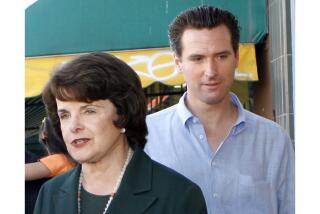Hawaii governor questions deathbed drama in heated Senate race

Hawaii Gov. Neil Abercrombie, shown addressing his supporters on election night 2010, disputes the oft-told story that he spurned the death-bed wishes of the late U.S. Sen. Daniel Inouye by appointing his lieutenant governor as Inouye’s replacement.
- Share via
HONOLULU — For political and emotional drama, it’s hard to top this: U.S. Sen. Daniel Inouye, the most beloved and respected figure in Hawaii state history, makes a death-bed request to name his successor in Washington.
But the governor, a fellow Democrat who has clashed with Inouye, spurns the dying senator’s plea and appoints his own lieutenant governor to the seat.
The result, playing out more than a year later, is a closely fought and emotionally wrought primary battle between the novice senator, Brian Schatz, and Inouye’s choice, Rep. Colleen Hanabusa: a Democrat-on-Democrat fight tinged with ethnic and generational tension and haunted, inevitably, by the ghost of Inouye and his last wish.
But now Gov. Neil Abercrombie has challenged that much-told narrative, implying that it had been manufactured to pressure him into choosing Hanabusa. He questioned whether Inouye even wrote the letter, marked “personal” and dispatched just before he died, seeking Hanabusa’s appointment. And he said that, in more than one conversation, the late senator stated his preference for Hanabusa but made it clear that the decision ultimately was Abercrombie’s.
“I received that letter, ostensibly coming from Sen. Inouye himself, a half an hour before he died in Washington, D.C. Literally,” Abercrombie said in a lengthy interview Thursday. “Whether or not this could be construed as Sen. Inouye’s dying wish — let me put it this way — is problematic.”
Later he elaborated, saying the circumstances were “far from the drama … with which it’s been characterized.”
“I think it was kind of created,” Abercrombie said. “ I don’t dispute for a second it represented his thinking, but it’s far from being a dying wish, sent from Washington and signed and sealed … by Sen. Inouye in Washington.”
A spokesman for Hanabusa said the letter reflected Inouye’s unequivocal sentiments, written in his own words.
“Obviously he didn’t sit at the computer and type it up, but he dictated the contents of that letter in the week leading up” to his death, said Peter Boylan, communications director for Hanabusa’s campaign and deputy chief of staff to Inouye at the time of his death.
Though not privy to any private conversations between the governor and the senator, Boylan said, he never heard Inouye express anything but abundant praise and a strong desire to have Hanabusa succeed him. Conveying those feelings, Boylan said, was one of the few things Inouye made a priority in his final days.
The two men had a long and not always agreeable history. Inouye, who was active in politics from statehood and helped turn Hawaii into today’s overwhelmingly Democratic bastion, sometimes backed Abercrombie opponents in earlier races. He was not happy with Abercrombie’s decision to give up his long-held House seat and run for governor in 2010.
But during the interview at his campaign headquarters, Abercrombie spoke of Inouye with admiration and said both men were professional enough as politicians to look past their differences.
“We worked together hand in glove for 20 years,” he said, his voice rising. “To have others characterize our relationship on the basis of their perception of politics, it’s not just inaccurate, it completely misses the actual nature of this relationship.”
Abercrombie said the question of succession actually come up after another Hawaii senator, Daniel Akaka, announced plans to retire in 2012. At one point, Abercrombie said, there was talk of Akaka stepping down early, so his successor could be named immediately and gain seniority over others elected in November.
It was then, Abercrombie said, that Inouye stated his preference for Hanabusa. But, the governor said, he also told him, “In the end, as governor, you have to make the decision you think is best for the people of Hawaii. It’s up to you. … And of course he’d say that because he was the person he was, which is to say a consummate politician in the best sense of that word.”
Inouye’s death in December 2012 came suddenly, even before Akaka — who ended up finishing his term — had left the Senate. It was then Abercrombie received the letter from Washington describing Inouye’s dying wish that Hanabusa succeed him. Although it was marked “personal,” the governor noted acidly, it was also released to the media.
“I don’t argue a bit that represented his sentiments,” Abercrombie said, even as he questioned the letter’s authorship. “I say with equal certainty that I also know he admonished me to do what I thought was best for the people of Hawaii.”
Under state law, Abercrombie was given a list of three possible successors, provided by the Hawaii Democratic Party: Hanabusa, Schatz and Esther Kiaaina, deputy head of the state Department of Land and Natural Resources.
Abercrombie chose Schatz, in part, he said, because of his youth. He is 41 and Hanabusa is 62 and that gives him the potential, Abercrombie said, to serve longer in the Senate and accrue more power.
The Democratic primary is Aug. 9 and the Senate contest, all sides agree, is too close to call.
Twitter: @markzbarabak
More to Read
Sign up for Essential California
The most important California stories and recommendations in your inbox every morning.
You may occasionally receive promotional content from the Los Angeles Times.













